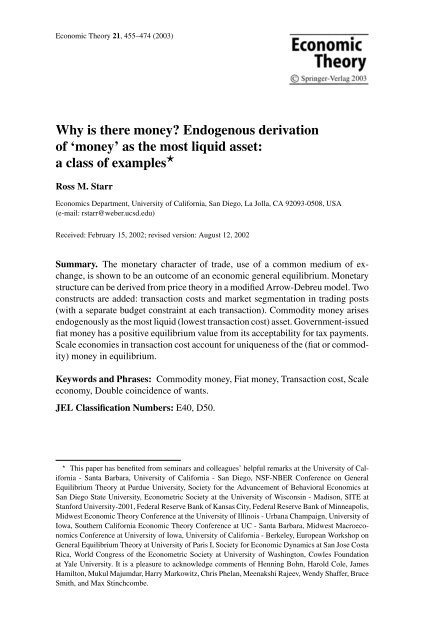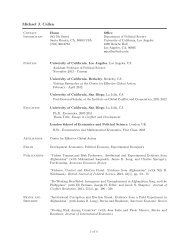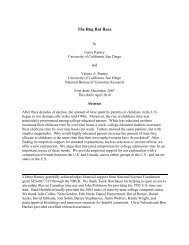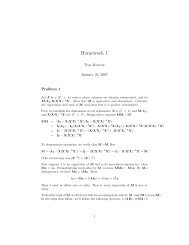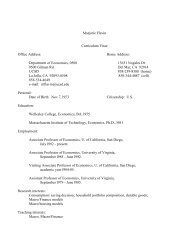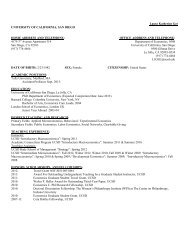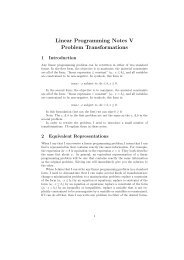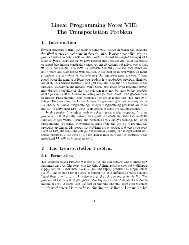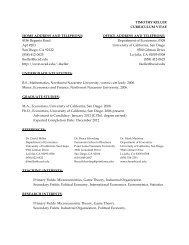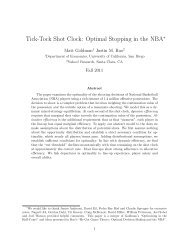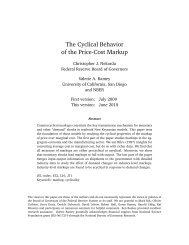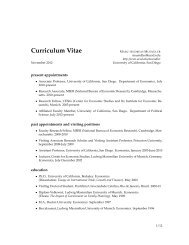Endogenous derivation of 'money' - UC San Diego Department of ...
Endogenous derivation of 'money' - UC San Diego Department of ...
Endogenous derivation of 'money' - UC San Diego Department of ...
Create successful ePaper yourself
Turn your PDF publications into a flip-book with our unique Google optimized e-Paper software.
Economic Theory 21, 455–474 (2003)<br />
Why is there money? <strong>Endogenous</strong> <strong>derivation</strong><br />
<strong>of</strong> ‘money’ as the most liquid asset:<br />
a class <strong>of</strong> examples ⋆<br />
Ross M. Starr<br />
Economics <strong>Department</strong>, University <strong>of</strong> California, <strong>San</strong> <strong>Diego</strong>, La Jolla, CA 92093-0508, USA<br />
(e-mail: rstarr@weber.ucsd.edu)<br />
Received: February 15, 2002; revised version: August 12, 2002<br />
Summary. The monetary character <strong>of</strong> trade, use <strong>of</strong> a common medium <strong>of</strong> exchange,<br />
is shown to be an outcome <strong>of</strong> an economic general equilibrium. Monetary<br />
structure can be derived from price theory in a modified Arrow-Debreu model. Two<br />
constructs are added: transaction costs and market segmentation in trading posts<br />
(with a separate budget constraint at each transaction). Commodity money arises<br />
endogenously as the most liquid (lowest transaction cost) asset. Government-issued<br />
fiat money has a positive equilibrium value from its acceptability for tax payments.<br />
Scale economies in transaction cost account for uniqueness <strong>of</strong> the (fiat or commodity)<br />
money in equilibrium.<br />
Keywords and Phrases: Commodity money, Fiat money, Transaction cost, Scale<br />
economy, Double coincidence <strong>of</strong> wants.<br />
JEL Classification Numbers: E40, D50.<br />
⋆ This paper has benefited from seminars and colleagues’ helpful remarks at the University <strong>of</strong> California<br />
- <strong>San</strong>ta Barbara, University <strong>of</strong> California - <strong>San</strong> <strong>Diego</strong>, NSF-NBER Conference on General<br />
Equilibrium Theory at Purdue University, Society for the Advancement <strong>of</strong> Behavioral Economics at<br />
<strong>San</strong> <strong>Diego</strong> State University, Econometric Society at the University <strong>of</strong> Wisconsin - Madison, SITE at<br />
Stanford University-2001, Federal Reserve Bank <strong>of</strong> Kansas City, Federal Reserve Bank <strong>of</strong> Minneapolis,<br />
Midwest Economic Theory Conference at the University <strong>of</strong> Illinois - Urbana Champaign, University <strong>of</strong><br />
Iowa, Southern California Economic Theory Conference at <strong>UC</strong> - <strong>San</strong>ta Barbara, Midwest Macroeconomics<br />
Conference at University <strong>of</strong> Iowa, University <strong>of</strong> California - Berkeley, European Workshop on<br />
General Equilibrium Theory at University <strong>of</strong> Paris I, Society for Economic Dynamics at <strong>San</strong> Jose Costa<br />
Rica, World Congress <strong>of</strong> the Econometric Society at University <strong>of</strong> Washington, Cowles Foundation<br />
at Yale University. It is a pleasure to acknowledge comments <strong>of</strong> Henning Bohn, Harold Cole, James<br />
Hamilton, Mukul Majumdar, Harry Markowitz, Chris Phelan, Meenakshi Rajeev, Wendy Shaffer, Bruce<br />
Smith, and Max Stinchcombe.
456 R. M. Starr<br />
“[An] important and difficult question...[is] not answered by the approach<br />
taken here: the integration <strong>of</strong> money in the theory <strong>of</strong> value...”<br />
Gerard Debreu, Theory <strong>of</strong> Value (1959)<br />
1 Money in Walrasian general equilibrium<br />
Consider four commonplace observations on the character <strong>of</strong> trade in virtually all<br />
economies:<br />
(i) Trade is monetary. One side <strong>of</strong> almost all transactions is the economy’s common<br />
medium <strong>of</strong> exchange.<br />
(ii) Money is (virtually) unique. Though each economy has a ‘money’ and the<br />
‘money’ differs among economies, almost all the transactions in most places<br />
most <strong>of</strong> the time use a single common medium <strong>of</strong> exchange.<br />
(iii) ‘Money’ is government-issued fiat money, trading at a positive value though<br />
it conveys directly no utility or production.<br />
(iv) Even transactions displaying a double coincidence <strong>of</strong> wants are transacted<br />
with money. 1<br />
Where economic behavior displays such uniformity, a general elementary economic<br />
theory should be able to account for the universal usages. But (i), (ii), and (iii)<br />
contradict the implications <strong>of</strong> a frictionless Walrasian general equilibrium model,<br />
and (iv) contradicts the conventional view <strong>of</strong> the role <strong>of</strong> money with regard to the<br />
double coincidence <strong>of</strong> wants. This essay presents a class <strong>of</strong> examples with a slight<br />
modification <strong>of</strong> the Arrow-Debreu general equilibrium model sufficient to derive<br />
points (i)–(iv) as outcomes. In doing so, this essay responds to a challenge expressed<br />
by Tobin (1980)<br />
Social institutions like money are public goods ... General equilibrium<br />
theory is not going to explain the institution <strong>of</strong> a monetary ... common<br />
means <strong>of</strong> payment.<br />
Thus the examples below are intended to show that a general equilibrium model<br />
can explain endogenously from price theory the institution <strong>of</strong> a common monetary<br />
means <strong>of</strong> payment. 2 The price system itself designates ‘money’ and guides transactors<br />
to trade using ‘money.’ The model emphasizes complete markets and complete<br />
1 University <strong>of</strong> California faculty whose children are enrolled at the University pay fees in money,<br />
not in kind; Ford employees buying a Ford car pay in money, not in kind; Albertson’s supermarket<br />
checkout clerks acquiring groceries pay in money, not in kind. This observation suggests that the focus<br />
on the absence <strong>of</strong> double coincidence <strong>of</strong> wants – as distinct from transaction costs – as an explanation<br />
for the monetization <strong>of</strong> trade may miss a significant part <strong>of</strong> the underlying causal mechanism.<br />
2 A bibliography <strong>of</strong> the issues involved in this inquiry appears in Ostroy and Starr (1990). In addition,<br />
note particularly Banerjee and Maskin (1996), Hellwig (2000), Howitt (2000), Howitt and Clower<br />
(2000), Iwai (1996), Kiyotaki and Wright (1989), Marimon et al. (1990), Rajeev (1999), Rey (2001),<br />
Trejos and Wright (1995), and Young (1998). The treatment <strong>of</strong> transaction costs in this essay (as opposed<br />
to the recent focus in the literature on search and random matching equilibria) resembles the general<br />
equilibrium models with transaction cost developed in Foley (1970); Hahn (1971); Starrett (1973), and<br />
Kurz (1974). The structure <strong>of</strong> bilateral trade here however is more detailed, with a budget constraint<br />
enforced on each transaction separately, so that the Foley, Hahn, and Starrett models do not immediately<br />
translate to the present setting.
Why is there money? 457<br />
information. Points (ii) and (iv) involve scale economies, nonconvex transaction<br />
costs; it will typically be difficult to develop general existence <strong>of</strong> equilibrium theorems<br />
– hence the use <strong>of</strong> examples.<br />
It is well known that a frictionless Arrow-Debreu model cannot accomodate<br />
a role for money. The single budget constraint facing transactors in the model<br />
precludes a carrier <strong>of</strong> value between transactions. This essay is intended as a partial<br />
counterexample, demonstrating that minimal friction in trade is sufficient to induce<br />
the existence <strong>of</strong> money as a result, not an assumption. The monetary structure <strong>of</strong><br />
the economy is derived from elementary price theory in a class <strong>of</strong> examples. Use <strong>of</strong><br />
a common medium <strong>of</strong> exchange, a commodity money, is an outcome <strong>of</strong> the market<br />
equilibrium. Starting from a (non-monetary) Arrow-Debreu model, the monetary<br />
quality <strong>of</strong> the economic equilibrium is derived through the addition <strong>of</strong> market<br />
segmentation (with a separate budget constraint in each segment) and transaction<br />
costs. Multiplicity <strong>of</strong> budget constraints – requiring that goods acquired be paid<br />
for by delivery <strong>of</strong> equal value at each trade separately – creates a demand for<br />
media <strong>of</strong> exchange. Transaction costs imply differing bid and ask prices for each<br />
good. Liquidity is priced: its price is the bid/ask spread. The most liquid asset,<br />
the instrument that provides liquidity at lowest cost, will be chosen as the medium<br />
<strong>of</strong> exchange. Thus, the choice <strong>of</strong> a (possibly unique) ‘money’ is the outcome <strong>of</strong><br />
optimizing behavior <strong>of</strong> economic agents in a market equilibrium. Fiat money –<br />
issued by government – derives its positive value from acceptability in payment <strong>of</strong><br />
taxes; it becomes the medium <strong>of</strong> exchange from its low transaction cost. Uniqueness<br />
<strong>of</strong> (fiat or commodity) money follows from scale economy in transaction costs.<br />
Section 3 <strong>of</strong> the paper presents the model <strong>of</strong> segmented markets with linear<br />
transaction costs without double coincidence <strong>of</strong> wants. Commodity money arises<br />
endogenously in market equilibrium. Section 4 demonstrates that the absence <strong>of</strong><br />
double coincidence <strong>of</strong> wants is essential to monetization <strong>of</strong> trade in a linear model<br />
by considering the same problem with full double coincidence <strong>of</strong> wants. The result<br />
is a nonmonetary equilibrium. Section 6 considers a (nonconvex) transaction<br />
technology with scale economies. The examples there demonstrate that uniqueness<br />
<strong>of</strong> money (uniqueness <strong>of</strong> the endogenously chosen medium <strong>of</strong> exchange) results<br />
from scale economies in transaction costs. Further, Section 6 demonstrates that<br />
scale economies in transaction cost account for monetization <strong>of</strong> trade with a unique<br />
‘money’ even when there is full double coincidence <strong>of</strong> wants. Section 7 considers<br />
government-issued fiat money whose value is supported by acceptability in<br />
payment <strong>of</strong> taxes. In a linear transaction cost model, fiat money’s (assumed) low<br />
transaction cost makes it the common medium <strong>of</strong> exchange. Alternatively, in a<br />
nonlinear model, scale economies in transaction cost and government’s large scale<br />
ensure that fiat money is the unique common medium <strong>of</strong> exchange. 3<br />
3 Space does not permit a full discussion distinguishing random matching models <strong>of</strong> money, e.g.<br />
Kiyotaki and Wright (1989), Trejos and Wright (1995), from general equilibrium models with transaction<br />
cost, e.g. Foley (1970), Hahn (1971), Starrett (1973), Ostroy and Starr (1974), Iwai (1996), and this<br />
essay. The latter typically model more complete markets and greater reliance on the price system.
458 R. M. Starr<br />
2 Formalizing menger’s ‘origin <strong>of</strong> money’<br />
Why is there money? is one <strong>of</strong> the classic issues in the foundations <strong>of</strong> economic<br />
theory, with contributions extending from Smith’s Wealth <strong>of</strong> Nations, to the present.<br />
Money, like written language and the wheel, is one <strong>of</strong> the fundamental discoveries<br />
<strong>of</strong> civilization. Nevertheless, despite the evident superiority <strong>of</strong> monetary trade over<br />
barter, there is a puzzling quality to monetary exchange. Monetary trade involves<br />
one party to a transaction giving up something desirable (labor, his production, a<br />
previous acquisition) for something useless (a fiduciary token or a commonly traded<br />
commodity for which he has no immediate use) in the hope <strong>of</strong> advantageously<br />
retrading this latest acquisition. An essential issue at the foundations <strong>of</strong> monetary<br />
theory is to articulate the elementary economic conditions that allow this paradox<br />
to be sustained as an individually rational market equilibrium.<br />
Over a century ago, Carl Menger presented the paradox <strong>of</strong> monetary trade as a<br />
challenge to monetary theory and proposed an outline <strong>of</strong> its solution, a theory <strong>of</strong><br />
liquidity as the basis <strong>of</strong> monetary theory, Menger (1892):<br />
It is obvious ... that a commodity should be given up by its owner ...for<br />
another more useful to him. But that every[one] ... should be ready to exchange<br />
his goods for little metal disks apparently useless as such...or for<br />
documents representing [them]...is...mysterious... why...is...economic<br />
man ...ready to accept a certain kind <strong>of</strong> commodity, even if he does<br />
not need it,... in exchange for all the goods he has brought to market[?]<br />
[Call] goods ... more or less saleable, according to the ... facility with<br />
which they can be disposed <strong>of</strong> ... at current purchasing prices or with<br />
less or more diminution... Men ... exchange goods ... for other goods<br />
... more saleable....[which] become generally acceptable media <strong>of</strong> exchange<br />
[emphasis in original].<br />
Menger’s proposed solution focused on the liquidity <strong>of</strong> commodities. A good is<br />
very saleable (liquid) in Menger’s definition above, if the price at which a household<br />
can sell it (the market’s prevailing bid price) is very near the price at which it can<br />
buy (the market’s prevailing ask price). In this setting, price theory includes a theory<br />
<strong>of</strong> liquidity. The segmented market creates a demand for a carrier <strong>of</strong> value between<br />
transactions. Separate bid and ask prices represent transaction costs and put a price<br />
on liquidity: a good’s bid/ask spread is the price <strong>of</strong> using it as a medium <strong>of</strong> exchange.<br />
Hence, a good with a uniformly narrow bid/ask spread is highly liquid – in Menger’s<br />
word ‘saleable’ – and constitutes a natural ‘money.’ Price theory implies monetary<br />
theory. Liquidity creates monetization. This is the insight that will be formalized<br />
in the examples below.<br />
Starting from the non-monetary Arrow-Debreu model, two additional structures<br />
are sufficient to give endogenous monetization in equilibrium: multiple budget<br />
constraints (one at each transaction, not just on net trade) and transaction costs.<br />
One way <strong>of</strong> formalizing multiple budget constraints is a trading post model. Thus,<br />
if there are N goods actively traded, there are N(N − 1)/2 possible trading posts.<br />
That is the starting point <strong>of</strong> the examples below. The choice <strong>of</strong> which trading<br />
posts a typical household will trade at is part <strong>of</strong> the household optimization. The
Why is there money? 459<br />
Figure 1. Monetary equilibrium with unique money<br />
equilibrium structure <strong>of</strong> exchange is the array <strong>of</strong> trading posts that actually host<br />
active trade. The determination <strong>of</strong> which trading posts are active in equilibrium is<br />
endogenous to the model and characterizes the monetary character <strong>of</strong> trade. The<br />
equilibrium is monetary with a unique money if only (N − 1) trading posts are<br />
active, those trading all goods against ‘money.’<br />
The examples below derive monetary equilibrium as a market equilibrium <strong>of</strong><br />
optimizing agents based on elementary considerations <strong>of</strong> transaction cost. Household<br />
optimization includes deciding at which trading posts the household will trade.<br />
For a given mix <strong>of</strong> goods, trade is drawn to the lowest transaction cost trading posts.<br />
The question Why is there money? can then be answered by presenting sufficient<br />
conditions so that an equilibrium trading array has N −1 active trading posts, those<br />
trading in a common medium <strong>of</strong> exchange versus the N − 1 other goods. This is<br />
illustrated in Figures 1 and 2. Each node in the figures represents a commodity.<br />
Active trade is represented by a chord between nodes. A barter economy will have<br />
chords among a wide variety <strong>of</strong> goods – one for each pair <strong>of</strong> goods where there is<br />
a household with a matching demand and supply (Fig. 2). A monetary economy<br />
with a unique money will be a sparser array. There will be one good so that the<br />
only chords are those linking that good to all others (Fig. 1). The question why is<br />
there money? is then reduced to asking for sufficient conditions so that the array <strong>of</strong><br />
active trading posts in equilibrium looks like Figure 1 (spider-shaped) instead <strong>of</strong><br />
Figure 2 (star-shaped).
460 R. M. Starr<br />
Figure 2. Barter equilibrium for H D<br />
3 Monetization comes from liquidity:<br />
monetary competitive equilibrium with linear transaction costs<br />
The distinctive features <strong>of</strong> the model are (i) transactions exchange pairs <strong>of</strong> goods,<br />
(ii) budget constraints are enforced at each transaction separately, generating a role<br />
for a carrier <strong>of</strong> value between transactions (a medium <strong>of</strong> exchange), (iii) transaction<br />
costs are assumed to be linear in Sections 3 and 4 and nonconvex (displaying scale<br />
economies) in Sections 5, 6, and 7. In the linear transaction cost case without double<br />
coincidence <strong>of</strong> wants, the most liquid (lowest transaction cost) good becomes the<br />
common medium <strong>of</strong> exchange. There may be multiple media <strong>of</strong> exchange when<br />
there is a tie for lowest cost.<br />
Let there be N +1commodities, numbered 0,1,2,...N. They are traded in pairs<br />
– good i for good j – at specialized trading posts. The trading post for trade <strong>of</strong> good<br />
i versus good j (and vice versa) is designated {i, j}; trading post {i, j} is identical<br />
to trading post {j, i}. Trading post {i, j} is a business firm, the market maker in<br />
trade between goods i and j. {i, j} actively buys and (re)sells both i and j. Trade<br />
as a resource using activity is modeled by describing the post’s transaction costs.<br />
The notion <strong>of</strong> transaction technology summarizes costs that in an actual economy<br />
are incurred by retailers, wholesalers, individual firms and households. The bid/ask<br />
spread summarizes these costs to the model’s transactors.<br />
Specify a transaction cost function for these pairwise trading posts so that all<br />
transaction costs accrue in good 0. It is simplest to think <strong>of</strong> good 0 as the labor
Why is there money? 461<br />
used in the transaction technology. This is obviously a restrictive convention, but<br />
it simplifies accounting for transaction costs. Trading post {i, j} buys good 0 as<br />
an input to its transaction costs. The typical transactions <strong>of</strong> trading post {i, j} will<br />
consist <strong>of</strong> purchases y {i,j}B<br />
i ,y {i,j}B<br />
j ,y {i,j}B<br />
0 ≥ 0, <strong>of</strong> i, j, and 0 respectively and<br />
sales y {i,j}S<br />
i ,y {i,j}S<br />
j ≥ 0 <strong>of</strong> i and j. In this section, we use the further simplifying<br />
assumption <strong>of</strong> linear transaction costs. The cost structure is generalized to nonconvex<br />
costs in Sections 5, 6, and 7.<br />
The transaction cost function for trading post {i, j} is4 C {i,j} = y {i,j}B<br />
0<br />
= δ i y {i,j}B<br />
i<br />
+ δ j y {i,j}B<br />
j<br />
(TCL)<br />
where δ i , δ j > 0. In words, the transaction technology looks like this: Trading<br />
post {i, j} makes a market in goods i and j, buying each good in order to resell<br />
it. It incurs transaction costs in good 0. These costs vary directly (in proportions<br />
δ i ,δ j ) with volume <strong>of</strong> trade. The transaction cost structure is separable in the two<br />
principal traded goods. The trading post {i, j} buys good 0 to cover the transaction<br />
costs it incurs, paying for 0 in goods i and j. The transaction cost function C {i,j} is<br />
sufficiently flexible to distinguish transaction costs differing among commodities,<br />
including differences in durability, portability, recognizibility, divisibility.<br />
The population <strong>of</strong> households is denoted H, consisting <strong>of</strong> a mix <strong>of</strong> subpopulations<br />
(with different tastes and endowments). A typical household hɛH, has an<br />
endowment r h ɛR N + ; r h n is h’s endowment <strong>of</strong> good n. For simplicity in the examples<br />
below, each household is endowed with only one commodity. This is obviously<br />
inessential. h’s utility function is u h (x) =u h (x0,x1, ..., xN).<br />
It is convenient to arrange a subpopulation H 0 to provide good 0 (transaction<br />
labor). H 0 ’s endowment <strong>of</strong> good 0 is characterized as<br />
<br />
r h 0 > N<br />
hεH 0<br />
hεH i=1<br />
δ i r h i . For typical hɛH 0 ,h ′ s utility function is<br />
u h (x) =<br />
N<br />
xi. (U0)<br />
i=0<br />
That is, a subpopulation H0 owns all <strong>of</strong> the good 0; they have it in sufficient quantity<br />
to cover all the transaction costs in the economy that are likely to be incurred; their<br />
tastes treat all goods as perfect substitutes with MRS equal to unity. This unrealistic<br />
assumption is designed to make accounting for transaction costs particularly easy.<br />
A typical household outside <strong>of</strong> H0 may be denoted h =[m, n] where m and<br />
n are integers between 1 and N (inclusive). m denotes the good with which h is<br />
endowed. n denotes the good h prefers. [m, n]’s utility function can then be taken<br />
to be<br />
u [m,n] (x) =<br />
N<br />
i=0,i=n<br />
4 (TCL) is intended as a mnemonic for linear transaction cost.<br />
xi +3xn. (U1)
462 R. M. Starr<br />
[m, n]’s endowment, r [m,n]<br />
m , is specified as part <strong>of</strong> the description <strong>of</strong> the subpopulation.<br />
Households formulate their trading plans deciding how much <strong>of</strong> each good to<br />
trade at each pairwise trading post. This leads to the rather messy notation:<br />
b [m,n]{i,j}<br />
ℓ<br />
= planned purchase <strong>of</strong> good ℓ by household [m, n]<br />
at trading post {i, j}<br />
s [m,n]{i,j}<br />
ℓ = planned sale <strong>of</strong> good ℓ by household [m, n] at trading post{i, j}<br />
The bid prices (the prices at which the trading post will buy from households) at<br />
{i, j} are q {i,j}<br />
i ,q {i,j}<br />
j for goods i and j respectively. The price <strong>of</strong> i is in units <strong>of</strong> j.<br />
The price <strong>of</strong> j is in units <strong>of</strong> i. The ask price (the price at which the trading post will<br />
sell to households) <strong>of</strong> j is the inverse <strong>of</strong> the bid price <strong>of</strong> i (and vice versa). That<br />
<br />
is, q {i,j}<br />
−1 <br />
i and q {i,j}<br />
−1 j are the ask prices <strong>of</strong> j and i at {i, j}. The trading<br />
post {i, j} covers its costs by the difference between the bid and ask prices <strong>of</strong> i<br />
<br />
and j, that is, by the spread q {i,j}<br />
−1 j −q {i,j}<br />
<br />
i and the spread q {i,j}<br />
−1 i −q {i,j}<br />
j .<br />
Transaction costs at the trading post are incurred in good 0. Post {i, j} pays for 0<br />
in i and j, acquired in trade through the difference in bid and ask prices. The bid<br />
price <strong>of</strong> 0 in terms <strong>of</strong> i is q {i,j}<br />
(i)0 . The bid price <strong>of</strong> 0 in terms <strong>of</strong> j is q{i,j}<br />
(j)0 .<br />
Given q {i,j}<br />
i ,q {i,j}<br />
j , for all {i, j} household h then forms its buying and selling<br />
plans, in particular deciding which trading posts to use to execute his desired trades.<br />
Household hɛH faces the following constraints on its transaction plans:<br />
(T.i) b h{i,j}<br />
n<br />
(T.ii) b h{i,j}<br />
i<br />
> 0, only if n = i, j; s h{i,j}<br />
n<br />
≤ q {i,j}<br />
j<br />
· s h{i,j}<br />
j<br />
,b h{i,j}<br />
j<br />
> 0, only if n = i, j, 0.<br />
≤ q {i,j}<br />
i<br />
· s h{i,j}<br />
i<br />
for each {i, j}.<br />
There is a slightly distinct version <strong>of</strong> (T.ii), (T.ii ′ ), applying to households in H 0 .<br />
s h{i,j}<br />
(j)0<br />
(T.ii ′ )ForhɛH 0 , decompose s h{i,j}<br />
0<br />
and b h{i,j}<br />
j<br />
, so that s h{i,j}<br />
(i)0<br />
≤ q {i,j}<br />
(j)0<br />
+sh{i,j}<br />
(j)0<br />
· sh{i,j}<br />
(j)0<br />
into nonnegative elements s h{i,j}<br />
(i)0<br />
= sh{i,j} 0 , then we have b h{i,j}<br />
i<br />
for each {i, j}.<br />
(T.iii) x h n = r h n + Σ {i,j}b h{i,j}<br />
n<br />
− Σ {i,j}s h{i,j}<br />
n<br />
≤ q {i,j}<br />
(i)0<br />
≥ 0, 0 ≤ n ≤ N.<br />
and<br />
· sh{i,j}<br />
(i)0<br />
Note that condition (T.ii) [and (T.ii’)] defines a budget balance requirement at<br />
the transaction level, implying the decentralized character <strong>of</strong> trade. Since the budget<br />
constraint applies to each pairwise transaction separately, there may be a demand<br />
for a carrier <strong>of</strong> value to move purchasing power between distinct transactions. h<br />
,q {i,j}<br />
, and chooses s h{i,j}<br />
,n= i, j<br />
faces the array <strong>of</strong> bid prices q {i,j}<br />
i<br />
j<br />
n<br />
and b h{i,j}<br />
n<br />
(and n =0for hɛH 0 ), to maximize u h (x h ) subject to (T.i), (T.ii), (T.iii). That is,<br />
h chooses which pairwise markets to transact in and a transaction plan to optimize<br />
utility, subject to a multiplicity <strong>of</strong> pairwise budget constraints.<br />
The trading posts in Sections 3 and 4 have linear transaction technologies. A<br />
competitive equilibrium is an appropriate solution concept resulting in zero pr<strong>of</strong>its<br />
,
Why is there money? 463<br />
for the typical trading post (with the additional benefit that no account need be<br />
taken <strong>of</strong> distribution <strong>of</strong> pr<strong>of</strong>its). The threat <strong>of</strong> entry (by other similar trading post<br />
firms) rationalizes the competitive model, but for simplicity we take there to be a<br />
unique trading post firm making a market in goods i and j, denoted indiscriminately<br />
{i, j} = {j, i}.<br />
A competitive equilibrium under (TCL) consists <strong>of</strong> q o{i,j}<br />
(i)0 q o{i,j}<br />
(i)0 , q o{i,j}<br />
i ,<br />
q o{i,j}<br />
j , 1 ≤ i, j ≤ N, so that:<br />
• For each household h ∈ H , there is a utility optimizing plan b oh{i,j}<br />
n<br />
(subject to T.i, T.ii [or T.ii ′ for h ∈ H 0 ], T.iii) so that Σhb oh{i,j}<br />
n<br />
Σhs oh{i,j}<br />
n<br />
• y o{i,j}S<br />
n<br />
• y o{i,j}B<br />
0<br />
y o{i,j}B<br />
(i)0<br />
= y o{i,j}B<br />
n<br />
≤ y o{i,j}B<br />
n<br />
, for each {i, j}, each n, where<br />
, n = i, j.<br />
can be divided into two parts, y o{i,j}B<br />
(i)0<br />
+y o{i,j}B<br />
(j)0<br />
• q o{i,j}<br />
(i)0 yo{i,j}B<br />
(i)0<br />
q o{i,j}<br />
(j)0 yo{i,j}B<br />
(j)0<br />
• δi + δjq o{i,j}<br />
i<br />
δj + δi q o{i,j}<br />
j<br />
= C {i,j} .<br />
≤ y o{i,j}B<br />
i − q o{i,j}<br />
j y o{i,j}B<br />
j .<br />
≤ y o{i,j}B<br />
j − q o{i,j}<br />
i y o{i,j}B<br />
i .<br />
<br />
= q o{i,j}<br />
−1 <br />
(i)0 1 − q o{i,j}<br />
i q o{i,j}<br />
<br />
j ,<br />
−1 <br />
=<br />
q o{i,j}<br />
<br />
= y o{i,j}B<br />
0<br />
q o{i,j}<br />
(j)0<br />
1 − q o{i,j}<br />
i<br />
j<br />
≥ 0,y o{i,j}B<br />
(j)0<br />
,s oh{i,j}<br />
n<br />
= y o{i,j}S<br />
n<br />
,<br />
,<br />
≥ 0, so that<br />
The expression in the last bullet is a marginal cost pricing condition: the transaction<br />
cost (in good 0) <strong>of</strong> buying one unit <strong>of</strong> i and enough j to pay for it (pricing<br />
the 0 in good i) is equal to the amount <strong>of</strong> i left over after completing the trade in i<br />
and j. Similarly for trade in j.<br />
An equilibrium is said to be monetary with a unique money, µ, if – for all<br />
households – good µ is the only good that a household will both buy and sell.<br />
An equilibrium will be monetary with multiple moneys, µ 1 ,µ 2 , ...., if – for all<br />
households – µ 1 ,µ 2 , .... are the only goods that a household will both buy and sell.<br />
Jevons (1875) reminds us that monetization <strong>of</strong> trade follows in part from the<br />
absence <strong>of</strong> a double coincidence <strong>of</strong> wants. In the present model, that logic is particularly<br />
powerful. Absence <strong>of</strong> coincidence <strong>of</strong> wants means that the typical traded<br />
good will be traded more than once in moving from endowment to consumption.<br />
Barter trade successfully rearranging the allocation to an equilibrium will transact<br />
an endowment first at the trading post where it is supplied and again at a distinct<br />
post where it is demanded. Hence monetary trade as an alternative (substituting<br />
retrade <strong>of</strong> money for the retrade <strong>of</strong> nonmonetary goods) can be undertaken without<br />
increasing total trading volume or transaction cost, even without scale economies.<br />
Conversely, when there is a full double coincidence <strong>of</strong> wants and linear transaction<br />
cost, equilibrium will be non-monetary even in the presence <strong>of</strong> a natural money<br />
(Section 4).<br />
We now formalize the notion <strong>of</strong> the absence <strong>of</strong> double coincidence <strong>of</strong> wants. Let<br />
N be an integer, N ≥ 3.Form =1, 2, ..., N, and positive integers i, 1 ≤ i ≤ N −1,
464 R. M. Starr<br />
let<br />
<br />
m + i if m + i ≤ N,<br />
m ⊕ i =<br />
m + i − N if m + i>N.<br />
That is, m ⊕ i denotes m + i mod N, skipping 0 (since good 0 is used primarily<br />
as an input to the transaction process). Recall that [m, n] denotes a household<br />
endowed with good m, strongly preferring good n. Using the notation above, let<br />
H1 = {[m, m ⊕ 1]|m =1, 2, ..., N; r [m,m⊕1]<br />
m = A > 0}. H1 characterizes a<br />
population <strong>of</strong> N households with the same size <strong>of</strong> initial endowment, so that no<br />
pair <strong>of</strong> them have reciprocal matching endowments and preferences but so that<br />
their endowments in aggregate can be reallocated to make each one significantly<br />
better <strong>of</strong>f (roughly by arranging the households clockwise in a circle ordered by<br />
endowment good and having each household [m, m⊕1] send his endowment one<br />
place counterclockwise).<br />
Example 3.1. Let the population <strong>of</strong> households be H = H 0 ∪ H 1 . Let C {i,j} be<br />
described by (TCL). Let 0
Why is there money? 465<br />
should have an explanation. Example 3.2 below emphasizes, by counterexample,<br />
that the nonconvexity in Section 5 is important. In Example 3.2, absent the nonconvexity,<br />
when there’s a tie for lowest transaction cost, there are many media <strong>of</strong><br />
exchange in use. Is a tie realistic; isn’t it a singularity? The example <strong>of</strong> dollars,<br />
sterling, and euros suggests that on the contrary, the notion <strong>of</strong> a tie for lowest<br />
transaction cost is a non-trivial event, so that uniqueness requires an explanation.<br />
Example 3.2. Let the population <strong>of</strong> households be H = H 0 ∪ H 1 . Let C {i,j}<br />
be described by (TCL). Let 0
466 R. M. Starr<br />
unique competitive equilibrium allocation. The equilibrium is non-monetary with<br />
active trade in all trading posts {i, j}, 1 ≤ i, j ≤ N.<br />
Demonstration <strong>of</strong> Example 4.1. For each i, j, 1 ≤ i, j ≤ N, q {i,j}<br />
i<br />
= A, b [j,i]{i,j}<br />
i<br />
=(1−δi ),<br />
q {i,j}<br />
j =(1−δj ). s [i,j]{i,j}<br />
i = A, b [i,j]{i,j}<br />
j = q {i,j}<br />
i A, s [j,i]{i,j}<br />
j<br />
=<br />
q {i,j}<br />
j A. Markets clear. The allocation is an equilibrium.<br />
What’s happening in Example 4.1? Direct barter trade works successfully in<br />
the presence <strong>of</strong> double coincidence <strong>of</strong> wants. For each household [i, j] with a<br />
supply <strong>of</strong> one good and a demand for another, there is a precise mirror image [j, i]<br />
in the population. They each go to the trading post {i, j} where their common<br />
demands and supplies are traded. They trade, each incurring the cost <strong>of</strong> trading one<br />
good. Monetary trade is not advantageous since it requires twice the transactions<br />
volume – with corresponding cost – <strong>of</strong> direct barter trade (similar volumes for each<br />
non-monetary good and an equal volume <strong>of</strong> trade in the medium <strong>of</strong> exchange).<br />
Monetization <strong>of</strong> trade in equilibrium in a linear model depends on absence <strong>of</strong><br />
double coincidence <strong>of</strong> wants.<br />
5 Uniqueness <strong>of</strong> the medium <strong>of</strong> exchange:<br />
scale economies in transaction cost<br />
Monetary trade is typically characterized by a unique medium <strong>of</strong> exchange or a<br />
small number <strong>of</strong> related media. How does this come about? Pr<strong>of</strong>essor Tobin (1980)<br />
suggests that scale economies in transaction costs are essential:<br />
The use <strong>of</strong> a particular language or a particular money by one individual<br />
increases its value to other actual or potential users. Increasing returns<br />
to scale ... explains the tendency for one basic language or money to<br />
monopolize the field.<br />
When monetization takes place, households supplying good i and demanding<br />
good j are induced to trade in a monetary fashion, first trading i for ‘money’ and<br />
then ‘money’ for j, by discovering that transaction costs are lower in this indirect<br />
trade than in direct trade <strong>of</strong> i for j. But as Example 3.2 points out, monetization <strong>of</strong><br />
trade is no guarantee <strong>of</strong> uniqueness <strong>of</strong> the medium <strong>of</strong> exchange. Scale economies<br />
in transaction costs induce specialization in the medium <strong>of</strong> exchange function.<br />
High volume leads to low unit transaction costs (see also Rey, 2001; Starr and<br />
Stinchcombe, 1999). Scale economy is not a necessary condition for uniqueness <strong>of</strong><br />
the medium <strong>of</strong> exchange in equilibrium (Example 3.1), but scale economy helps<br />
to ensure uniqueness (Example 6.1, below). If there are many equally low cost<br />
candidates for the medium <strong>of</strong> exchange, then scale economy in transaction costs<br />
will allow one to be endogenously chosen as the unique medium <strong>of</strong> exchange.
Why is there money? 467<br />
6 Monetization comes from liquidity again:<br />
monetary general equilibrium with unique money<br />
under average cost pricing <strong>of</strong> non-convex transaction costs<br />
Scale economies in the transaction cost structure induce uniqueness <strong>of</strong> the equilibrium<br />
medium <strong>of</strong> exchange. As Pr<strong>of</strong>essor Tobin (1959) tells us, “Why are some<br />
assets selected by a society as generally acceptable media <strong>of</strong> exchange while others<br />
are not? This is not an easy question, because the selection is self-justifying.” Thus<br />
gold and dollar bills may have low transaction costs and be excellent candidates<br />
for medium <strong>of</strong> exchange, but if (despite high transaction cost) Yap Island stones<br />
are already the commonly chosen medium <strong>of</strong> exchange with high trading volume,<br />
then stones may have the lowest average transaction cost. The choice <strong>of</strong> Yap Island<br />
stones as the common medium <strong>of</strong> exchange is then self-justifying.<br />
The nonconvex (scale economy) cost function for trading post {i, j} is<br />
C {i,j} = y {i,j}B<br />
0<br />
= min[δ i y {i,j}B<br />
i ,γ i ] + min[δ j y {i,j}B<br />
j ,γ j ] (TCNC) 5<br />
where δ i ,δ j ,γ i ,γ j > 0. In words, the transaction technology looks like this: Trading<br />
post {i, j} makes a market in goods i and j, buying each good in order to resell<br />
it. It incurs transaction costs in good 0. These costs vary directly (in proportions<br />
δ i ,δ j ) with volume <strong>of</strong> trade at low volume and then hit a ceiling after which they<br />
do not increase with trading volume. The specification in (TCNC) is an extreme<br />
case: zero marginal transaction cost beyond the ceiling. Adding additional linear<br />
terms would represent a more general case.<br />
Since the trading posts in this economy have nonconvex transaction technologies,<br />
a competitive equilibrium is not an appropriate solution concept. The equilibrium<br />
notion used is an average cost pricing equilibrium resulting in zero pr<strong>of</strong>its for<br />
the typical trading post firm. The rationale for this choice <strong>of</strong> equilibrium concept is<br />
the threat <strong>of</strong> entry (by other similar firms) if any economic rent is actually earned.<br />
The presence <strong>of</strong> potential entrants and their actions is not explicitly modeled.<br />
An average cost pricing equilibrium consists <strong>of</strong> q o{i,j}<br />
(i)0 , q o{i,j}<br />
(j)0 , q o{i,j}<br />
i , q o{i,j}<br />
j ,<br />
1 ≤ i, j ≤ N, so that :<br />
• For each household h, there is a utility optimizing plan b oh{i,j}<br />
n<br />
to T.i, T.ii [or T.ii ′ for hɛH 0 ], T.iii) so that Σhb oh{i,j}<br />
n<br />
= y o{i,j}B<br />
n<br />
• y o{i,j}S<br />
n<br />
• y o{i,j}B<br />
0<br />
y o{i,j}B<br />
(i)0<br />
• q o{i,j}<br />
(i)0<br />
q o{i,j}<br />
i<br />
, for each {i, j}, each n, where<br />
,n= i, j.<br />
≤ y o{i,j}B<br />
n<br />
can be divided into two parts, y o{i,j}B<br />
(i)0<br />
+y o{i,j}B<br />
(j)0<br />
y o{i,j}B<br />
(i)0<br />
y o{i,j}B<br />
.<br />
i<br />
= y o{i,j}B<br />
0<br />
= C {i,j} .<br />
= y o{i,j}B<br />
i − q o{i,j}<br />
j<br />
, s oh{i,j}<br />
, (subject<br />
n<br />
= y o{i,j}S<br />
n<br />
≥ 0,y o{i,j}B<br />
(j)0<br />
y o{i,j}B<br />
j .q o{i,j}<br />
(j)0 y o{i,j}B<br />
(j)0<br />
5 (TCNC) is intended as a mnemonic for non-convex transaction cost.<br />
, Σhs oh{i,j}<br />
n<br />
≥ 0, so that<br />
= y o{i,j}B<br />
j −
468 R. M. Starr<br />
Let κ be a positive integer, 2
Why is there money? 469<br />
<strong>of</strong> exchange in equilibrium when trading volume κA is sufficiently high. Mintstandardized<br />
gold coins (with a low cost transaction technology) or Yap Island<br />
stones (high cost technology) may be ‘money’ depending on which is well estab-<br />
lished. Sufficient trading volume can confirm either choice.<br />
Recall H D = {[m, n]|m, n =1, 2, 3, ..., N, m = n, r [m,n]<br />
m<br />
= A>0}. H D is<br />
a set <strong>of</strong> N(N −1) households with full double coincidence <strong>of</strong> wants. The following<br />
Example 6.2 demonstrates that even in the presence <strong>of</strong> double coincidence <strong>of</strong> wants,<br />
sufficient scale economies in transaction costs can lead to monetization <strong>of</strong> trade,<br />
the use <strong>of</strong> a common medium <strong>of</strong> exchange.<br />
Example 6.2. Let the population <strong>of</strong> households be H = H 0 ∪ H D . Let C {i,j}<br />
be described by (TCNC). Let 0 < δi < +∞ all i = 1, 2, ..., N. For some i<br />
and all j, 1 ≤ i, j ≤ N, i = j, let γi +γ j<br />
2<br />
(N−1)A < 3 and<br />
<br />
1 − γi +γ j <br />
(N−1)A > (1 −<br />
δj <br />
), 1 − γi +γ j <br />
(N−1)A > (1 − δi ). Then there is a monetary average cost pricing<br />
equilibrium with good i as the unique ‘money.’<br />
Demonstration <strong>of</strong> Example 6.2. For all j = i, j = 1, 2, ..., N, let q {i,j}<br />
i<br />
q {i,j}<br />
j<br />
q {j,k}<br />
k<br />
q {i,m}<br />
i<br />
=1− γi +γ j<br />
(N−1)A<br />
= 1 − δ k . Let s [m,n]{i,m}<br />
m<br />
A, b [m,n]{i,n}<br />
n<br />
. For all j, and k =1, 2, ..., N, j = k = i, q{j,k}<br />
j<br />
= q {i,m}<br />
i<br />
A.<br />
= A, b [m,n]{i,m}<br />
i<br />
= 1,<br />
=1− δj ,<br />
=<br />
= q {i,m}<br />
i A, s [m,n]{i,n}<br />
i<br />
What’s happening in Example 6.2? Monetization comes from liquidity and –<br />
with scale economies – liquidity comes from trading volume. But how can monetization<br />
<strong>of</strong> trade occur where there is double coincidence <strong>of</strong> wants? The answer is<br />
scale economies. Trader [m, n] wants to trade good m for good n. He could do so directly<br />
at post {m, n}, and he’d find a willing trading counterpart at the trading post,<br />
so he’d only have to pay for the transaction costs on one side <strong>of</strong> the trade. But the<br />
transaction costs are still substantial, reducing his return on the trade to A(1 − δ m )<br />
units <strong>of</strong> n after starting with A units <strong>of</strong> good m. The alternative is to trade good<br />
m for good i and then trade i for n. This results in A(1 − [(γ i + γ n )/(N − 1)A])<br />
units <strong>of</strong> n. When N is sufficiently large, that’s a much greater return. Because <strong>of</strong><br />
the narrow bid/ask spread on trade through i, every market with good i on one<br />
side attracts high trading volume, N − 1 traders on each side <strong>of</strong> the market, the<br />
high trading volume needed to maintain good i’s low bid/ask spreads. The scale<br />
economy means that the choice <strong>of</strong> good i as the common medium <strong>of</strong> exchange is<br />
self-confirming. 6<br />
7 Government-issued fiat money<br />
In order to study fiat money we introduce a government with the unique power<br />
to issue fiat money. Fiat money is intrinsically worthless; it enters no one’s utility<br />
6 For a network externality interpretation see Hahn (1997) which notes that in the presence <strong>of</strong> market<br />
set-up costs, each transactor in the market benefits from the participation <strong>of</strong> others. Young (1998)<br />
assumes the externality without additional explanation. Rey (2001) denotes this interaction the “thick<br />
markets externality.
470 R. M. Starr<br />
function. But the government is uniquely capable <strong>of</strong> declaring it acceptable in<br />
payment <strong>of</strong> taxes. Adam Smith (1776) notes “A prince, who should enact that a<br />
certain proportion <strong>of</strong> his taxes be paid in a paper money <strong>of</strong> a certain kind, might<br />
thereby give a certain value to this paper money...” (v. I, book 2, ch. 2). Abba<br />
Lerner (1947) comments, “The modern state can make anything it chooses generally<br />
acceptable as money...if the state is willing to accept the proposed money in payment<br />
<strong>of</strong> taxes.”<br />
Taxation – and fiat money’s guaranteed value in payment <strong>of</strong> taxes – explains the<br />
positive equilibrium value <strong>of</strong> fiat money. 7 Scale economies explain its uniqueness<br />
as the medium <strong>of</strong> exchange.<br />
As an economic agent, government is denoted G. Government sells tax receipts,<br />
the N +1 st good. It also sells good N +2, an intrinsically worthless instrument,<br />
(latent) fiat money, that government undertakes to accept in payment <strong>of</strong> taxes, that is,<br />
in exchange for N +1. The typical household [m, n] in H 1 or H κ desires to purchase<br />
tax receipts to the extent it prefers not to have a quarrel with the government’s tax<br />
authorities. Government sets a target tax receipt purchase by the taxayer <strong>of</strong> τ [m,n] .<br />
Then we rewrite [m, n]’s utility function as:<br />
u [m,n] (x) =<br />
N<br />
i=0,i=n<br />
xi +3xn − 10[max[(τ [m,n] − x [m,n]<br />
N+1 ), 0]] (UT)<br />
That is, household [m, n] values paying his taxes with a positive marginal utility<br />
up to his tax bill τ [m,n] and with zero marginal utility for tax payments thereafter.<br />
Government uses its revenue to purchase a variety <strong>of</strong> goods n =1, ..., N, inthe<br />
amount x G n .<br />
Good N +2good represents latent fiat money. Government, G, sells N +1(tax<br />
receipts) for N +2at a fixed ratio <strong>of</strong> one-for-one. The trading post {N +1,N +<br />
2} where tax receipts are traded for N +2operates with zero transaction cost.<br />
Acceptability in payment <strong>of</strong> taxes ensures N +2’s positive value. If, in addition,<br />
N +2is assumed to have sufficiently low transaction cost, then it becomes the<br />
common medium <strong>of</strong> exchange. Thus the existence <strong>of</strong> a fiat money equilibrium with<br />
assumed low linear transaction cost is merely an application <strong>of</strong> Example 3.1 and<br />
need not be repeated here.<br />
Government-issued fiat money is typically the unique common medium <strong>of</strong><br />
exchange: in the US virtually all transactions are denominated in US dollars; in<br />
the UK virtually all (nonfinancial) transactions are denominated in pounds sterling.<br />
The virtual uniqueness <strong>of</strong> the monetary instrument is not merely a possibility; it<br />
seems to be a general fact. Dollars, euros, pounds sterling, and other governmentissued<br />
fiat money’s all seem to have similar low transaction costs. But in any<br />
single market economy precisely one <strong>of</strong> these instruments is likely to be the unique<br />
common medium <strong>of</strong> exchange. Example 7.1 harnesses scale economy to explain<br />
why fiat money is (almost universally) the unique common medium <strong>of</strong> exchange.<br />
Particularly in the case <strong>of</strong> scale economies in the transactions technology, there<br />
is a strong tendency to multiple equilibria (recall Example 6.1). This creates an<br />
7 See also Li and Wright (1998) and Starr (1974).
Why is there money? 471<br />
interest in determining which <strong>of</strong> the several equilibria the economy will actually<br />
select. One solution to this problem is to posit an adjustment process to equilibrium<br />
that makes the choice. Hence we use the following Tatonnement adjustment process<br />
for average cost pricing equilibrium: Prices will be adjusted by an average cost<br />
pricing auctioneer. Specify the following adjustment process for prices.<br />
Step 0. The starting point is somewhat arbitrary. In each pairwise market the bid/ask<br />
spread is set at average cost for low trading volume.<br />
Cycle 1, step 1. Households compute their desired trades at the posted prices and<br />
report them for each pairwise market.<br />
Step 2. Average costs (and average cost prices) are computed for each pairwise<br />
market based on the outcome <strong>of</strong> STEP 1. Prices are adjusted upward for goods in<br />
excess demand at a trading post, downward for goods in excess supply, with the<br />
bid/ask spread adjusted to average cost.<br />
Cycle 2. Repeat Step 1 (at the new posted prices) and STEP 2.<br />
Cycle 3, Cycle 4. .... repeat until the process converges.<br />
This plausible adjustment process explains why government-issued fiat money<br />
becomes the unique common medium <strong>of</strong> exchange – and would do so even in the<br />
absence <strong>of</strong> legal tender rules. Government has two distinctive characteristics: it has<br />
the power to support the value <strong>of</strong> fiat money by making it acceptable in payment <strong>of</strong><br />
taxes; it is a large economic presence undertaking a high volume <strong>of</strong> transactions in<br />
the economy. Hence, government can make its fiat money the common medium <strong>of</strong><br />
exchange merely by using it as such. The scale economies implied will make fiat<br />
money the low transaction cost instrument and hence the most suitable medium <strong>of</strong><br />
exchange, not just for government but for all transactors.<br />
Example 7.1. Let the population <strong>of</strong> households be H = H0 ∪ Hκ . Let u [m,n] be<br />
described by (UT). Let τ o > 0 be a constant. Let 0
472 R. M. Starr<br />
For n, m = N +2,n= m, set q {m,n}<br />
n<br />
=(1− δ n ). q {N+2,n}<br />
n<br />
(1 − min[δ n ,γ n /κτ o ])(1 − γ N+2 /κτ o ),q {N+2,n}<br />
N+2<br />
=1.<br />
Cycle 2, Step 1.<br />
For n = 1, 2, ..., N, let s G{N+2,n}<br />
N+2 = κτ o , b G{N+2,n}<br />
n = κτ o q {N+2,n}<br />
N+2 ;<br />
s G{N+1,N+2}<br />
N+1 = Nκτo , b G{N+1,N+2}<br />
N+2 = Nκτo ; b [n,n⊕i]{N+2,N+1}<br />
N+1<br />
=<br />
τ o , s [n,n⊕i]{N+2,N+1}<br />
N+2 = τ o ; s [n,n⊕i]{N+2,n}<br />
n = A, b [n,n⊕i]{n,N+2}<br />
N+2 =<br />
Aq {N+2,n}<br />
n ; s [n,n⊕i]{n⊕i,N+2}<br />
N+2 = Aq {N+2,n}<br />
n − τ o , b [n,n⊕i]{n⊕i,N+2}<br />
<br />
Aq<br />
n⊕i<br />
=<br />
{N+2,n}<br />
n − τ o<br />
<br />
q {n⊕i,N+2}<br />
N+2 .<br />
Cycle 2, Step 2. For n, m = N +2, n = m, set q {m,n}<br />
n<br />
(1 − min[δn ,γn /κA]) (1 − γ {N+2} /κA), q {N+2,n}<br />
{N+2}<br />
Cycle 3, Step 1. Repeat Cycle 2, Step 1.<br />
=1.<br />
=<br />
=(1− δ n ). q {N+2,n}<br />
n<br />
Cycle 3, Step 2. Repeat Cycle 2, Step 2.<br />
Convergence.<br />
What’s happening in Example 7.1? Scale economies are taking their course!<br />
Government expenditures in all goods markets in exchange for N +2(and large<br />
household demand to acquire N +2to finance tax payments) result in a large<br />
trading volume on the trading posts for good N +2versus n =1, ..., N. Volume<br />
is large enough that scale economies kick in. The average cost pricing auctioneer<br />
adjusts prices, the bid/ask spread, to reflect the scale economies. The bid/ask spreads<br />
incurred on trading m for m ⊕ i by way <strong>of</strong> good N +2become considerably<br />
narrower than on trading m for m ⊕ i directly. The price system then directs each<br />
household to the market {m, N +2} where its endowment is traded against good<br />
N +2. The household sells all its endowment there for N +2and trades N +2<br />
subsequently for tax payments and desired consumption. Scale economy has turned<br />
N +2from a mere tax payment coupon into ‘money,’ the unique universally used<br />
common medium <strong>of</strong> exchange.<br />
8 Conclusion<br />
The monetary structure <strong>of</strong> trade in general equilibrium, the uniqueness <strong>of</strong> money,<br />
and the existence <strong>of</strong> a fiat money equilibrium can be derived from elementary price<br />
theory. The monetary character <strong>of</strong> trade, the existence <strong>of</strong> a common medium <strong>of</strong> exchange<br />
in economic equilibrium, can be logically derived from a (non-monetary)<br />
Arrow-Debreu Walrasian model through the addition <strong>of</strong> two constructs: segmented<br />
markets with multiple budget constraints (one at each transaction) and transaction<br />
costs. The multiplicity <strong>of</strong> budget constraints creates a demand for a carrier <strong>of</strong><br />
value (medium <strong>of</strong> exchange) between transactions. Money (the common medium<br />
<strong>of</strong> exchange) arises endogenously as the most liquid (lowest transaction cost) asset.<br />
Government-issued fiat money derives its value from acceptability in payment<br />
<strong>of</strong> taxes. Uniqueness <strong>of</strong> the monetary instrument (fiat or commodity money) in<br />
equilibrium comes from scale economies in transaction cost.<br />
=
Why is there money? 473<br />
Table 1. Equilibrium monetary structure<br />
Demand Returns to scale in transaction technology<br />
structure<br />
Linear transaction Increasing returns<br />
technology transaction technology<br />
Absence <strong>of</strong> double Monetary equilibrium Monetary equilibrium<br />
Coincidence <strong>of</strong> wants where the low transaction with unique ‘money’<br />
cost instrument becomes (Example 6.1)<br />
‘money’ (Example 3.1);<br />
Possibly multiple ‘moneys’<br />
(Example 3.2)<br />
Absence <strong>of</strong> double Fiat money equilibrium Fiat money equilibrium<br />
Coincidence <strong>of</strong> wants if fiat money is the low (‘money’ is unique) when tax<br />
with fiat money transaction cost instrument payments and government<br />
(Apply Example 3.1) purchases are sufficiently<br />
large (Example 7.1)<br />
Full double coincidence Nonmonetary equilibrium Monetary equilibrium with<br />
<strong>of</strong> wants (Example 4.1) unique ‘money’ (Example 6.2)<br />
The taxonomy <strong>of</strong> cases developed is depicted in Table 1.<br />
Absent double coincidence <strong>of</strong> wants, with linear transaction costs, a low transaction<br />
cost instrument is endogenously chosen as a medium <strong>of</strong> exchange. In the case<br />
<strong>of</strong> linear transaction costs, absence <strong>of</strong> double coincidence <strong>of</strong> wants is essential to<br />
monetary equilibrium. Alternatively scale economies in transaction cost (nonconvex<br />
transaction technology) lead to a corner solution, uniqueness <strong>of</strong> the common<br />
medium <strong>of</strong> exchange. Fiat money derives its positive value from acceptability in<br />
payment <strong>of</strong> taxes. Fiat money becomes the unique common medium <strong>of</strong> exchange<br />
when government taxation and purchases are sufficiently large that scale economies<br />
in transaction costs make it the low (average) transaction cost instrument.<br />
References<br />
Banerjee, A., Maskin, E.: A Walrasian theory <strong>of</strong> money and barter. Quarterly Journal <strong>of</strong> Economics<br />
CXI, (4), 955–1005 (1996)<br />
Debreu, G.: Theory <strong>of</strong> value. New York: Wiley 1959<br />
Foley, D.K.: Economic equilibrium with costly marketing. Journal <strong>of</strong> Economic Theory 2(3), 276–291<br />
(1970)<br />
Hahn, F.H.: Fundamentals. Revista Internazionale di Scienze Sociali CV, 123–138 (1997)<br />
Hahn, F.H.: Equilibrium with transaction costs. Econometrica 39(3), 417–439 (1971)<br />
Hellwig, C.: Money, intermediaries and cash-in-advance constraints. London School <strong>of</strong> Economics<br />
(2000) (pdf duplicated)<br />
Howitt, P.: Beyond search: fiat money in organized exchange. Ohio State University (2000) (pdf duplicated)<br />
Howitt, P., Clower, R.: The emergence <strong>of</strong> economic organization. Journal <strong>of</strong> Economic Behavior and<br />
Organization 41, 55–84 (2000)<br />
Iwai, K.: The bootstrap theory <strong>of</strong> money: a search theoretic foundation for monetary economics. Structural<br />
Change and Economic Dynamics 7, 451–477 (1996)<br />
Jevons, W.S.: Money and the mechanism <strong>of</strong> exchange. London: Macmillan 1875<br />
Kiyotaki, N., Wright, R.: On money as a medium <strong>of</strong> exchange. Journal <strong>of</strong> Political Economy 97, 927–954<br />
(1989)
474 R. M. Starr<br />
Kurz, M.: Equilibrium in a finite sequence <strong>of</strong> markets with transaction cost. Econometrica 42(1), 1–20<br />
(1974)<br />
Lerner, A.P.: Money as a creature <strong>of</strong> the state. Proceedings <strong>of</strong> the American Economic Association 37,<br />
312–317 (1947)<br />
Li, Y.,Wright, R.: Government transaction policy, media <strong>of</strong> exchange, and prices. Journal <strong>of</strong> Economic<br />
Theory 81, 290–313 (1998)<br />
Marimon, R., McGrattan, E., Sargent, T.: Money as a medium <strong>of</strong> exchange in an economy with artificially<br />
intelligent agents. Journal <strong>of</strong> Economic Dynamics and Control 14, 329–373 (1990)<br />
Menger, C.: On the origin <strong>of</strong> money. Economic Journal II, 239–255 (1892) (translated by C.A. Foley)<br />
Ostroy, J., Starr, R.: The transactions role <strong>of</strong> money. In: B Friedman, B., Hahn, F. (eds.) Handbook <strong>of</strong><br />
monetary economics. New York: Elsevier North Holland 1990<br />
Ostroy, J., Starr, R.: Money and the decentralization <strong>of</strong> exchange. Econometrica 42, 597–610 (1974)<br />
Rajeev, M.: Marketless set-up vs trading posts: a comparative analysis. Annales d’Economie et de<br />
Statistique 53, 197–211 (1999)<br />
Rey, H.: International trade and currency exchange. Review <strong>of</strong> Economic Studies 68 (2) (235), 443–464<br />
(2001)<br />
Smith, A.: Wealth <strong>of</strong> nations (1776)<br />
Starr, R.M.: The price <strong>of</strong> money in a pure exchange monetary economy with taxation. Econometrica<br />
42, 45–54 (1974)<br />
Starr, R.M., Stinchcombe, M.B.: Exchange in a network <strong>of</strong> trading posts. In: Chichilnisky, G. (ed.)<br />
Markets, information, and uncertainty: essays in economic theory in honor <strong>of</strong> Kenneth Arrow.<br />
Cambridge: Cambridge University Press 1999<br />
Trejos, A., Wright, R.: Search, bargaining, money and prices. Journal <strong>of</strong> Political Economy 103(1),<br />
118–141 (1995)<br />
Tobin, J.: The Tobin manuscript. New Haven, Yale University (1959)<br />
Tobin, J.: Discussion. In: Kareken, J., Wallace, N. Models <strong>of</strong> monetary economies. Minneapolis: Federal<br />
Reserve Bank <strong>of</strong> Minneapolis 1980<br />
Young, H.P.: Individual strategy and social structure: an evolutionary theory <strong>of</strong> institutions. Princeton:<br />
Princeton University Press 1998


